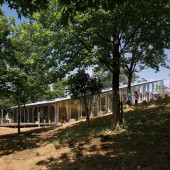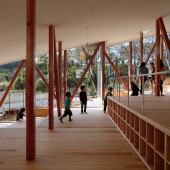Hakusui Nursery School Nursery school by Kentaro Yamazaki |
Home > Winners > #50079 |
 |
|
||||
| DESIGN DETAILS | |||||
| DESIGN NAME: Hakusui Nursery School PRIMARY FUNCTION: Nursery school INSPIRATION: This nursery school in Sakura, Chiba was planned to accommodate 60 pupils. Seiyu-Kai, a local social welfare firm specializing in elderly care facilities approached us for this project. The overarching concept for this plan started with an idea: “a nursery school is a large house.” Surrounded by mountains and forest, the southern area of the site rests on a gentle slope. Putting this topography to use, we designed the school room to resemble a large set of stairs. UNIQUE PROPERTIES / PROJECT DESCRIPTION: One unique feature of this "large house" is that a 3-year old child is in the same room as a 5-year old and these children of different ages can interact in the wide, one-room space. Additionally, should a 3 year-old child be sleeping while a 5 year old child plays nearby, these differences in rhythm reinforce the "domestic" qualities of this "large house." we made it a priority to minimize the number of blind-spots within the room in order to keep safety measures as unintrusive as possible. OPERATION / FLOW / INTERACTION: - PROJECT DURATION AND LOCATION: - FITS BEST INTO CATEGORY: Architecture, Building and Structure Design |
PRODUCTION / REALIZATION TECHNOLOGY: Utilizing large sliding window frames along the northern and southern faces, along with the space created by the slope, ventilation is created as a breeze draws in from the south of the structure, passes through the forest-like interior pillars making its way upwards before finally blowing out across the terrace on the northern side. A small pond on the southern end which gathers rainwater as well as water from sprinklers installed on the southward-slanted roof also contributes to the airflow as the water is absorbed into the wind that blows into the structure. This was part of a comprehensive plan to create a space that was inseparable from the environment that surrounds it. We believe that in pursuing the original concept of a “nursery school as a large house” we achieved something not unlike the houses in farming communities that surround it. SPECIFICATIONS / TECHNICAL PROPERTIES: - TAGS: Architecture, Nursery school, Children, landscape, RESEARCH ABSTRACT: The rich topography of Japan lends itself to valuable formative experiences of local elements such as wind and rain. These formative experiences in particular lead to understanding and attachment to the regional culture. Rooted in the regional geography, the childcare facility opens itself to the wind, the rain and the sunlight of the external environment and serves as an example of typical Asian facility development. For example, the sense of enjoying rain would not be nurtured in a typical, modern, climate-controlled facility. As water from the plum rain season falls off the roof and into the pond on the southern side, the pupils frolicking foster new experiences even with their parents. Additionally we hope the facility fosters creativity among the children. CHALLENGE: This nursery eliminates the dead area and improves the physical ability of children. Generally, nursery school facilities tend to be uniform from one to the other. Increasing options for the parents and providing an alternative to the norm attracts customer and leads to this nursery school succeeding on a commercial level. Also as the nursery school becomes established not only as a public care facility but also as a hub of community welfare it succeeds on a social level. Specifically, we placed an“observation stage” to foster sociability among the parents where they can look over on the nursery room and meet with each other. In addition, the facility also serves to foster interaction with the local elderly population in cooperation with a nearby elderly nursing home, hosting exhibitions for children’s work in openhouse events. ADDED DATE: 2016-08-31 12:23:35 TEAM MEMBERS (3) : Structural Design : ASD / Ryuji Tabata, Takayuki Tabata, Facility Design : yamada machinery office / Hiroyuki Yamada and Graphic Design : SHUNPEI YOKOYAMA DESIGN OFFICE / Shunpei Yokoyama IMAGE CREDITS: Naoomi Kurozumi |
||||
| Visit the following page to learn more: http://ykdw.org/ | |||||
| CLIENT/STUDIO/BRAND DETAILS | |
 |
NAME: Social welfare corporation Seiyukai PROFILE: - |
| AWARD DETAILS | |
 |
Hakusui Nursery School Nursery School by Kentaro Yamazaki is Winner in Architecture, Building and Structure Design Category, 2016 - 2017.· Read the interview with designer Kentaro Yamazaki for design Hakusui Nursery School here.· Press Members: Login or Register to request an exclusive interview with Kentaro Yamazaki. · Click here to register inorder to view the profile and other works by Kentaro Yamazaki. |
| SOCIAL |
| + Add to Likes / Favorites | Send to My Email | Comment | Testimonials | View Press-Release | Press Kit |
Did you like Kentaro Yamazaki's Architecture Design?
You will most likely enjoy other award winning architecture design as well.
Click here to view more Award Winning Architecture Design.







